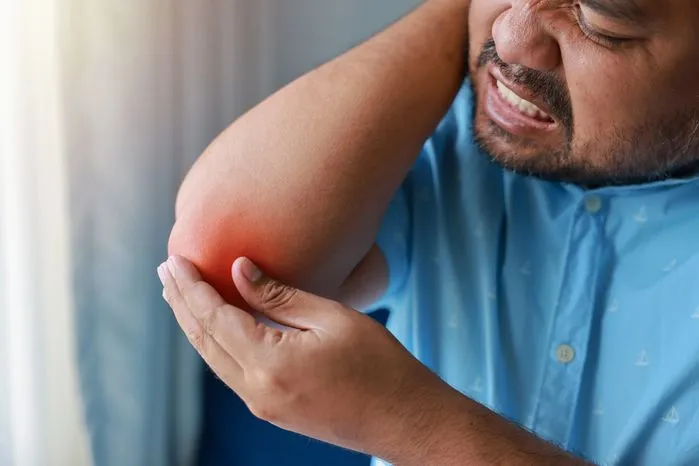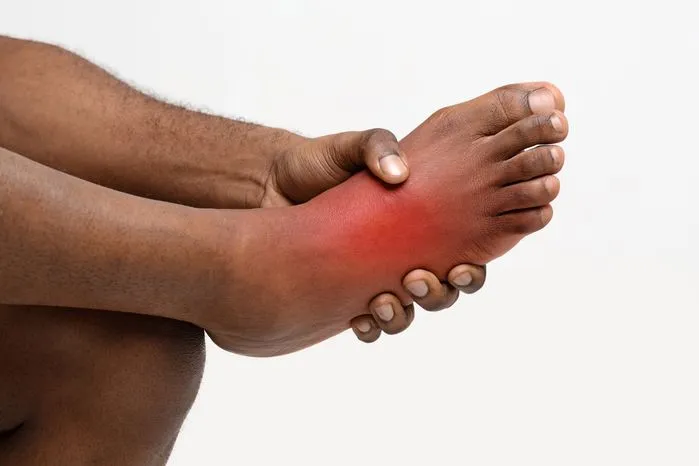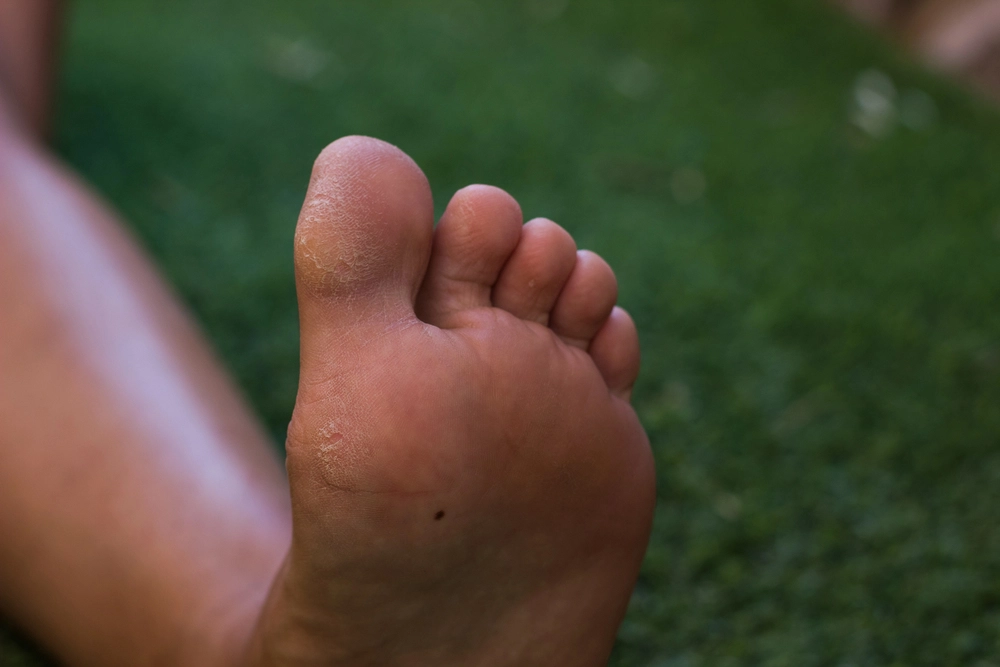
A simple foot pain will not be a problem for almost anyone until it becomes uncomfortable.
When you develop red spots on your feet, you may have reason to be alarmed. Athletes' foot, a fungus between toes, or dyshidrotic eczema, characterized by small blisters, may be the cause.
No one wants these disorders, yet infections, injuries, stress, and even favorite shoes can cause them. Fortunately, most of these issues respond positively to timely treatments.
Key Takeaways
- Athlete's foot and eczema can cause painful red spots due to infections, trauma, or poor cleanliness.
- Fungal Athlete's Foot produces itching, red spots, burning, and a terrible smell in humid environments.
- Stress or some medicines can trigger Dyshidrotic eczema, which produces foot blisters.
- These illnesses are treated with corticosteroids, antifungals, and store-bought moisturizers.
- Clean your feet, prevent irritants, and moisturize to reduce itching and irritation to avoid these illnesses.

What Are Painful Red Spots
Painful red spots on your feet may indicate foot problems. These patches can change in size and severity, and skin may become irritated, inflamed, or peel. Common reasons include inflammation and skin infections.
Inflammatory stimuli activate our immune system, causing redness, swelling, heat, and discomfort. Injury, medicine allergy, and sickness are triggers. These variables can produce red feet from plantar fasciitis, gout, and bursitis.
However, skin infections occur when bacteria, viruses, and fungi breach the skin's barrier. Foot infections can cause an athlete's foot, cellulitis, and ulcers. They appear as painful areas that may itch, leak, or smell foul. Recognizing these elements aids in identifying and managing typical foot diseases.
Causes of Common Foot Diseases
Understanding the causes of common foot disorders is essential for prevention and treatment. This knowledge builds on our familiarity with symptoms such as pain and red spots. Infections, injuries, poor hygiene practices, and specific latent health conditions often instigate these ailments.
Minor symptoms often mark the beginning of disease progression. If not promptly addressed, these may evolve into more severe issues. For example, a minor foot cut or scrape could pave the way for bacterial infections, culminating in conditions like cellulitis. Persistent pressure or friction on foot areas may also result in corns and calluses.
Risk factors significantly contribute to the occurrence of prevalent foot diseases. People with diabetes are more likely to develop foot complications due to impaired circulation and nerve damage. Foot problems like bunions and hammertoes often burden individuals persistently wearing poorly fitted shoes.

Unraveling Athletes Foot
Athlete's Foot, or Tinea Pedis, is a common foot ailment that requires immediate treatment. This fungal infection, which smells bad, causes itching, burning, and scaly skin between toes. It must be treated quickly to stop spreading.
Tinea Pedis thrives in humid areas, such as inside sweaty shoes or public showers. Regular foot hygiene, such as thoroughly drying feet after washing and wearing footwear that breathes well, contributes significantly to preventing this infection.
Over-the-counter antifungal treatments are often the first line of defense. Clotrimazole and terbinafine destroy and suppress fungi. Oral antifungals may be needed in severe situations.
Nevertheless, treatment alone doesn't suffice. Recurrence can be avoided by maintaining foot cleanliness, avoiding shared footwear, and changing socks regularly. Health professionals should be consulted for proper diagnosis and treatment.
Decoding Eczema on Feet
A common foot condition in adults is dyshidrotic eczema. Small blisters on foot soles cause irritation and oedema in this type of eczema. Stressful situations or seasonal shifts, known eczema provocateurs, frequently trigger these symptoms. Nickel and certain perfumes and cleaning agents can also cause flare-ups.
Avoiding these factors can significantly reduce flare-ups and discomfort. Regular moisturizing is essential for controlling eczema since parched skin can cause flare-ups.
Scratching can thicken and infect the skin. Hence, addressing itchiness with suitable medication or therapies is essential for disease management. Walking in breathable shoes and wearing natural socks can help keep your skin healthy and prevent future irritation.

Treatment and Prevention Strategies
Eczema management requires hygiene. Regular cleaning and moisturizing afflicted areas to avoid dryness and irritation. Avoiding triggers like allergies and irritants reduces flare-ups.
Medical professionals recommend corticosteroid creams, which reduce inflammation, itching, and redness. Over-the-counter moisturizers and emollients also hydrate skin.
Frequently Asked Questions
How do I eliminate red spots on the bottom of my feet?
Find out why your feet are red before treating them. Foot padding, breathable shoes, and clean, dry feet can reduce discomfort and friction-induced redness. OTCF creams or sprays help treat fungal red spots.
What causes spots on the bottom of your feet?
Unfit shoes, skin illnesses like eczema or psoriasis, fungal infections like athlete's foot, or underlying health conditions can cause foot patches. Watch for foot changes and seek medical treatment if you find persistent or worrying areas.
What are the red fungal spots on my feet?
Red foot spots may indicate an athlete's foot. A common fungal infection can cause red, itchy, and painful areas on the foot, especially between the toes and soles. Treatment usually comprises over-the-counter or prescription antifungals and keeping the feet clean and dry to prevent infection.
What foot infection has red dots?
Red foot spots may suggest cellulitis. Cellulitis, a skin infection that can affect any part of the body, including the foot, creates red, swollen, and sensitive areas that might progress unchecked.
What are hard, painful spots on feet?
Corns and calluses, which develop in response to pressure or friction, can cause foot pain. Wearing supportive shoes, using cushioning pads, and exfoliating can ease corn and callus pain. If the pain worsens, contact a podiatrist.
What causes the bottom of feet to be red and hurt?
Red, painful feet can result from fungus, germs, skin problems, and friction. The reason for redness and pain must be determined for treatment.
What diseases start with foot pain?
Foot discomfort can result from plantar fasciitis, arthritis, tendonitis, stress fractures, neuropathy, and PAD. A doctor can diagnose and treat you.
What does a red dot on the bottom of your foot mean?
Red foot dots may signify a minor injury, blood vessel rupture, callus, or skin infection. If the red dot hurts, lingers, or has other symptoms, visit a doctor.
What are the most common foot diseases?
Common foot issues include plantar fasciitis, bunions, corns, calluses, ingrown toenails, athlete's foot, heel spurs Pain, mobility difficulties, and discomfort reduce quality of life.
What diseases cause foot pain?
Foot pain can be caused by arthritis, gout, diabetes, peripheral neuropathy, plantar fasciitis, and tendonitis. It can also result from inflammation, nerve damage, joint stiffness, and anatomical anomalies.
What are the causes of athlete's foot disease?
Fungal athlete's foot is tinea pedis. Athlete’s foot is caused by barefoot walking in damp public spaces, tight, non-breathable shoes, and sweaty feet. Fungi favor warm, moist situations thus athletes, sweaters, and tight shoe wearers are more likely to get athlete's feet.
Which of the following is the common cause of an athlete's foot?
Going barefoot in damp public settings causes an athlete's foot. Locker rooms, pools, and community showers favor athlete's foot fungi.


















